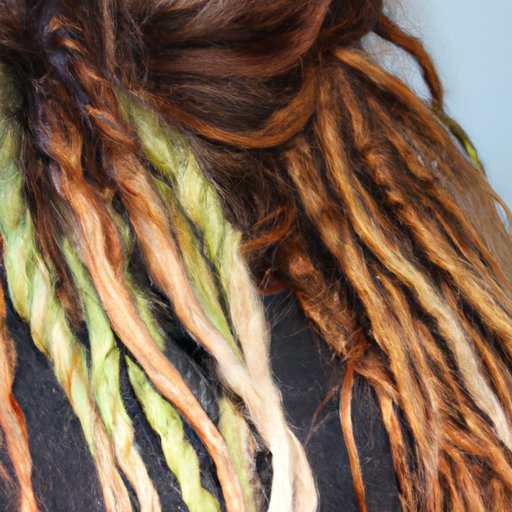
Introduction
Are you tired of traditional hairstyles and looking for something unique and eye-catching? Perhaps freeform dreadlocks are just what you need. These natural locks have gained popularity in recent years, particularly in the natural hair community. Freeform dreadlocks may appear messy, but in reality, their wildness represents a beautifully unique and organic style. In this article, we will discuss the step-by-step process of starting and maintaining freeform dreadlocks, DIY tips, budget-friendly techniques, transitioning from chemically-treated hair, and embracing the journey of natural hair.
Step-by-Step Guide to Freeform Dreadlocks: What You Need to Know
Gathering necessary tools and products
Before starting the freeform dreadlocks process, gather the necessary tools and products. You will need a wide-tooth comb or detangler brush, a spray bottle filled with water or diluted shampoo, clips, dread wax, and a bandana or headscarf. It is best to use natural hair products that do not contain harmful chemicals.
Starting the freeform dreadlocks process
Freeform dreadlocks are created by allowing the hair to naturally mat and form into dreadlocks. To start the process, wash your hair with a clarifying shampoo to remove any product build-up or oils. Towel-dry your hair and let it air dry for an hour or two.
Once your hair is slightly damp, separate it into sections using clips. Take a section and twist it tightly until it naturally knots. Repeat this process with each section, then tuck the tips inward, securing them together with a small amount of dread wax.
Maintaining and caring for freeform dreadlocks
To maintain freeform dreadlocks, it is essential to keep them clean. Wash your hair with a residue-free shampoo once a week, and wear a headscarf or bandana while sleeping to prevent frizzing. Use a spray bottle filled with water to dampen hair and maintain texture.
Troubleshooting common issues
One common issue with freeform dreadlocks is the presence of lint or bacteria. To avoid this, clean your hair regularly and avoid touching your locks with dirty hands. Another issue is unraveling dreads, which can occur due to lack of maintenance or improperly tucking in the ends. Secure the tips with a small amount of dread wax to prevent unraveling.
DIY Dreadlocks: How to Start and Maintain Freeform Locs
Step-by-step guide to starting and maintaining freeform dreadlocks
One benefit of DIY freeform dreadlocks is that you can avoid the high cost of professional installations. Follow the steps listed in the previous section to start and maintain your freeform locs.
Benefits of DIY dreadlocks versus professional installation
In addition to the cost savings, DIY dreadlocks allow you to have complete control over the process and customize your style to perfectly fit your individual tastes.
Tips and tricks for success
To ensure success when creating your own freeform dreadlocks, be patient, use high-quality natural hair products, and celebrate the uniqueness of your hair texture and length.
Tips and Tricks for Achieving Freeform Dreadlocks Without Breaking the Bank
Budget-friendly products and tools
If you are on a budget, there are many affordable products and tools you can use to create and maintain freeform dreadlocks. Look for natural hair products sold at your local drugstore or online, and use old t-shirts or towels instead of expensive hair wraps or scarfs.
Alternative methods for starting freeform dreadlocks
If you don’t want to twist your hair to start dreadlocks, consider the backcombing method or palmrolling method. Backcombing involves teasing the hair until it forms locks naturally, while palmrolling requires you to roll strands of hair tightly with your palms until they begin to lock.
Low-maintenance techniques for upkeep
If you have a busy lifestyle, low-maintenance techniques can help you maintain your freeform dreadlocks. Leave-in conditioners and oils can be used to moisturize and protect hair while reducing the need for regular washing.
Going Natural: A Beginner’s Guide to Freeform Locs
Transitioning from chemically-treated hair to freeform dreadlocks
If you have chemically-treated hair, transitioning to freeform dreadlocks can be a long process. You may need to cut off the damaged hair and allow for the new growth to flourish naturally. Transitioning not only allows for healthier hair, but also a better opportunity for the hair to lock naturally.
Managing the awkward phase of hair growth
During the early stages of freeform dreadlocks, hair growth can look awkward. To manage this phase, consider wearing hats or headbands to keep your hair in place. Additionally, consider having your locks styled by a professional to help navigate this phase.
Benefits of natural hair care
Natural hair care has many benefits, including reducing exposure to harmful chemicals, proper nourishment of the hair, and increased self-confidence through a unique and individual style.
The Art of Freeform Dreadlocks: How to Embrace the Journey and Love Your Locks
Understanding the uniqueness of your hair texture and length
Every person has a unique hair texture and length, which makes freeform dreadlocks even more special. Embrace your individuality and use it to create a one-of-a-kind style.
Cultivating patience and embracing imperfection
Freeform dreadlocks require patience as they can take months or even years to form fully. Embracing imperfection is also key, as no two human heads are the same. Letting go of the need for perfection can lead to a more fulfilling and truly unique style.
Finding inspiration in the freeform dreadlocks community
Connecting with other people who have freeform dreadlocks can be incredibly motivating and inspiring. Joining online communities or attending events to meet like-minded individuals can provide inspiration and support throughout the journey.
Conclusion
In conclusion, freeform dreadlocks offer a unique and individual style option that is gaining more and more traction, particularly in the natural hair community. Whether you are considering DIY dreadlocks or working with a professional, using budget-friendly techniques, transitioning from chemically-treated hair, or finding inspiration in the freeform dreadlocks community, this guide has you covered. Embrace your uniqueness, cultivate patience, and enjoy the journey of your freeform dreadlocks.





